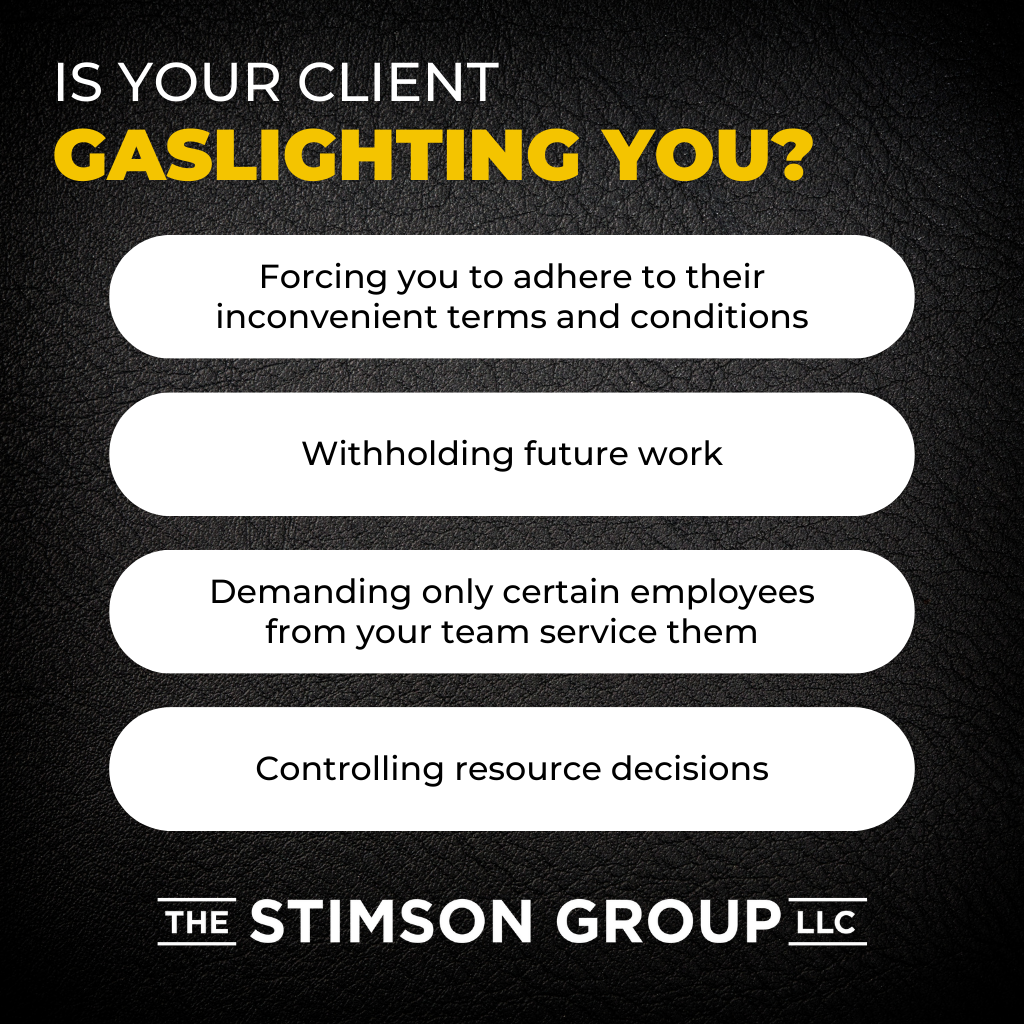
Listen instead on your Monday morning drive:
When I speak to my clients about scalability, they inevitably become hung up on one major customer. That customer represents 30–80% of their revenue, and companies fear making changes that could upset them or drive them away.
I understand not wanting to disrupt pricing or personnel. However, building your business around a single, dominant client makes beneficial change difficult. While big clients present some advantages, the drawbacks leave you vulnerable to gaslighting behavior.
The Tempting Trap of One Big Customer
A mega-client provides some benefits. The early insight into upcoming projects lets you schedule months in advance, and that reduces immediate pressure on your sales team.
However, these clients, which I call windfall clients, bring temporary booms instead of sustained, reliable growth. They generate opportunistic income rather than intentional income, and if that revenue train unexpectedly stalls, your business descends into famine.
When a windfall client dominates, you may overinvest in infrastructure and staff to meet their ballooning demands. But without a diverse customer portfolio to balance the risk, those investments lack security.
Windfall customers recognize your dependence on them. They can afford to pursue unprofitable business for themselves, knowing you’ll pad their budget later — and they do it again and again. You may have heard their refrain: “Hey, I need you guys to sharpen your pencil on this job. Don’t worry, I’ll make it up to you later!” This escalating accommodation makes you increasingly vulnerable.
The bowtie effect — extreme reliance on a single linchpin relationship — often plays a role here, and it’s a recipe for disaster. What happens when your contact retires or moves on? Who champions your relationship with the customer then?
Take it from one of my clients, who recently suffered the effects of a windfall customer: “We just found out a key contact had been phasing out, and it almost sank us,” he told me. “Thirty percent of our revenue disappeared overnight.”

Signs Your Major Client Is Taking Advantage
Initially, requests from your major client seem minor: a small concession here to keep the peace or an adjustment there to show flexibility. But soon, everything becomes negotiable, and those little asks snowball.
Before you know it, they openly compare your pricing to competitors that may or may not exist to (in their terms) “keep everybody honest.” They insist, “Vendor X’s labor price is 20% less than yours, and their video projector only costs $2,000.”
They pretend to collect comparative bids only to cherry-pick the best prices, line-by-line, to negotiate you down.
Alternatively, they try to leverage legacy. They review your latest quote and say, “We can’t afford that! We already budgeted this job based on what you charged us last year.” Now, you feel as though you can’t update your pricing, because they’ve already gone out and quoted jobs based on what you quoted them before.
Other hallmarks of gaslighting behavior include:
- Forcing you to adhere to their inconvenient terms and conditions, e.g., “You don’t get paid until I get paid by my customer.”
- Withholding future work, e.g., “Let’s get through our current project before we talk about what’s next.” Translation: “I’m assuming you won’t do a good job, and that’ll affect whether I do the next job with you, even though I’ve been doing business with you for years.” That’s the definition of not functioning in good faith.
- Demanding only certain employees from your team service them. While this may sound like a compliment, it undermines your entire business’s value.
- Controlling resource decisions like crew size, equipment selections, and project management strategy based purely on their budget rather than operational needs.
These start as little “innocent” requests but eventually become strategic leverage. You’re left doubting reasonable pricing and job scopes as they deny financial facts and operational constraints to get you to accept their reality.
No matter how they word it, the implicit threat is always the same: “You, a reasonable person, should accommodate me just this once, because all my business is at risk over this one point of contention. If you don’t accommodate me, that means you are unreasonable.”
But it’s never just once. This is your relationship’s perpetual state. Each demand seems relatively small, and you go along to preserve the relationship. But soon, you’re giving away the farm just to maintain the revenue, even as rising costs consume margins.
It’s gaslighting at its purest — leveraging disproportionate power by disorienting your sense of reality.
How Gaslighting Clients Impact Scalability
Gaslighting clients directly obstruct growth. Their ever-increasing demands take up all your bandwidth. Innovation stalls as you fight constant fires for them. And when you finally do land new business, they see these accounts as threats to their share of attention. Ultimately, you have little capacity left to grow.
Gaslighting clients also drive disproportionate investments of resources. You end up overspending on specialized labor and premium gear just to accommodate them. Their unpredictability makes you dependent on their next job.
So, when that client hits an inevitable bump in the road — the owner retires, they go out of business, their biggest client leaves — your entire business suffers.

Can You Have a Majority Client and Still Be Scalable?
Large clients aren’t universally bad, but issues arise when you build your entire business model around them. No single client should ever wield extreme power or operational control over you. As soon as you need them more than they need you, unhealthy dynamics emerge.
But with clear boundaries and realistic expectations in place, large clients can still be profitable without undermining scalability.
Watch Closely for Gaslighting
Watch for signs that you’re overly dependent on a single client or being taken advantage of. A gaslighting client:
- Negotiates on individual prices rather than full project budgets
- Forces you to adhere to their terms and conditions
- Withholds future work to leverage power and get their way
- Undermines the capabilities of your whole team
- Controls your resources and business decisions
Staying connected to your margins is a great way to identify gaslighting. Yes, margins are negotiable, but you need margins to make a profit. Owners who are aware of what things actually cost and how much money they need to make don’t allow themselves to be taken advantage of.
No single client, no matter how large, should ever compromise your overall growth and stability. Value your time and expertise enough to set firm relational boundaries. Only then can you build toward scalability.





Leave a Reply